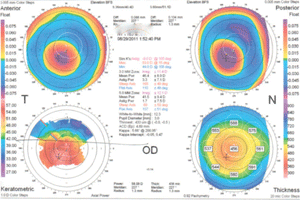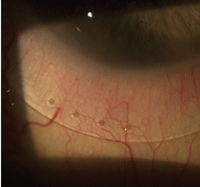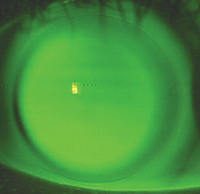 Gas permeable lenses and keratoconus have traditionally gone hand in hand. Many keratoconic patients suffer from visual deterioration that only a GP lens can improve. Unfortunately, in some instances, many of these patients are unable to wear GP lenses comfortably, which creates a constant struggle for these individuals. The GP lens bearing on the cornea can cause a dry, irritated sensation in the eyes, and in some instances, recurrent epithelial erosions.
Gas permeable lenses and keratoconus have traditionally gone hand in hand. Many keratoconic patients suffer from visual deterioration that only a GP lens can improve. Unfortunately, in some instances, many of these patients are unable to wear GP lenses comfortably, which creates a constant struggle for these individuals. The GP lens bearing on the cornea can cause a dry, irritated sensation in the eyes, and in some instances, recurrent epithelial erosions.
The recent availability of scleral GPs has allowed many individuals to experience significant improvement in lens comfort and tolerance, due to their fit characteristics of apical clearance and a maintained pre-corneal fluid chamber.
There are also some situations in which individuals can have highly irregular scleral shape. An asymmetric, irregular sclera—whether it is naturally occurring or the result of an ocular trauma or surgery—can present a challenge for eye care professionals when attempting to get an optimal fitting scleral lens.

1. Topography of the right eye demonstrating keratoconus.
A vaulting hybrid lens design, such as the SynergEyes ClearKone or UltraHealth, offers an alternative to scleral lenses when central corneal clearance is necessary. The advantage of a hybrid design is that the soft skirt will drape over highly irregular scleral shape and allow for a successful lens fit. Consider the following case, which demonstrates this very situation.
A Case Study
ND, a 34-year-old white male, presented with a history of Marfan’s syndrome. This condition led to dislocated crystalline lenses in each eye, lens extraction and aphakia. Some years later, he suffered a retinal detachment in his right eye, which was repaired successfully with a scleral buckle. He had worn GP lenses for his high hyperopia for several years with no issues; however, approximately three years prior to his initial visit with me, he noticed significant changes to his right eye due to the development of keratoconus (figure 1). His primary care optometrist had him refitted in new corneal GP lenses, but he was struggling with lens comfort, and was being referred for refitting of the keratoconic, aphakic right eye.
Following much testing and discussion, ND was eventually fitted into a 17.5mm scleral lens in his right eye. While the scleral lens did improve his lens comfort, it also led to significant 3-9 conjunctival redness and irritation. It was revealed at follow-up that the sclera was not spherical, so a lens with a toric landing zone was ordered to improve the fit. While the toric landing zone did in fact improve the fit, ND reported frequent issues with bubbles getting under the lens just moments after insertion.

2. A toric scleral lens on the right eye, with blanching adjacent to a well-aligned landing zone in the same quadrant.
After reviewing the proper insertion technique with a toric lens, it was clear that the bubbles had originated from the inferior landing zone area, as the steep meridians superiorly and inferiorly were not opposing each other. This caused the lens to alternately rotate and led to intermittent inferior edge lift, which allowed bubbles to get under the edge when the lens shifted counterclockwise (figure 2).
After reassessing his options, we attempted a fit in a SynergEyes ClearKone, with the hopes of letting the soft skirt drape the sclera and avoid edge life, while still vaulting the very centrally located nipple cone. A lens was successfully fit, with a vault of 300 and a medium skirt. However, due to his aphakia, the power needed was +11.50, which is not an available parameter. After consulting with the lab about this case, they agreed to make a special order lens with the necessary +11.50 power.
ND returned four weeks later to pick up the special order ClearKone lens. He was pleased with both the fit and vision. After wearing the lenses for a few weeks, the 300 vault was eventually exchanged in favor of a 350 vault (figure 3). He was able to use the new ClearKone without the issues he had with the scleral lens. Earlier this year, he was refitted into the new UltraHealth design to allow enhanced breathability with the high prescription.

3. A SynergEyes ClearKone lens on the right eye.
Conclusion
Scleral lenses are amazing tools to help patients get the vision they need when an irregular cornea exists. However, in certain cases, scleral irregularities may exist due to prior trauma, surgery or natural changes to the scleral surface. When this occurs, it can be difficult to get an even, aligned fit of the lens to the sclera. Quadrant-specific designs do exist for scleral lenses, and can often be employed in complex sclera situations. However, in cases where a hybrid lens is appropriate—such as in centrally located keratoconus—these lenses can be just as successful and potentially less complex.


